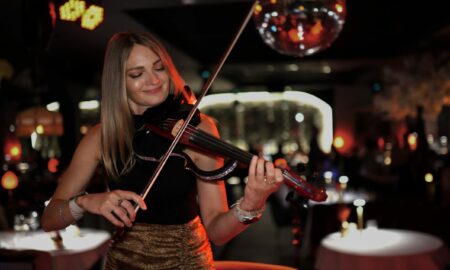

Today we’d like to introduce you to Alfonso Estrada.
Every artist has a unique story. Can you briefly walk us through yours?
One of the earliest and most influential introductions to art was from my great-aunt. She was a naturally gifted artist who, without any formal instruction, excelled at drawing and at art in general. I grew up in the mid 80’s/early 90’s and was inspired by the films, animated shows and comic books of that time. I loved to draw and wanted to get better at it. After school and on weekends, my aunt would be subjected to my constant requests to draw whatever my favorite characters and superheroes were at the moment. She never said no and being the more experienced artist that she was, would always end up giving me beautifully rendered drawings of whatever I asked for. My aunt’s drawings set a high bar for quality and inspired me to get better at my craft. I would spend hours drawing and trying to meticulously replicate pages out of comic books and characters from animated films and TV shows. I toiled over my drawings and would often become frustrated by the discrepancy between the artistic visions in my head and what ultimately ended up on the paper in front of me.
The pinnacle of my early creative career came when I brought a folder full of my own drawings to school for show and tell one day and presented it to my third grade class. By this time my skill level had significantly improved. Everyone was so enthusiastic about my work that by the end of my presentation they all began requesting original drawings from me. It was amazing to see my classmates responding so positively to something that I had created. It gave me a wonderful sense of pride and accomplishment. In retrospect it was a valuable learning experience that exposed me to the reciprocating relationship an artist has with their work, how that work effects an audience and how an audience in turn can influence the artist.
My creative interests continued throughout high school and ultimately led me to declare a major in traditional hand drawn animation with a minor in studio arts at Loyola Marymount University. At LMU the animation department was in the same building as the film school so there were a lot of shared courses and cross pollination between the two majors. As a result, I became really interested in live action cinematography, lighting and set design. I was still dedicated to animation but wanted to find a way where I could combine everything that I was learning and realized that stop-motion animation was the perfect intersection of all of these different disciplines. By my senior year I had decided to make a stop-motion animated film as my thesis and enjoyed the process so much that after graduation I decided to pursue a career in stop-motion animation.
Can you give our readers some background on your art?
I am a stop-motion director and animator. I move objects, puppets and on occasion people one increment at a time. I take a picture, incrementally move an object, take another picture and repeat this process until the images being taken can be played back in sequence to give the object the illusion of movement. Stop-motion animation has a reputation for being notoriously time consuming. For television animation every second on screen generally equates to an hour’s worth of work. This average can be even higher for feature films. That being said, all the technical aspects of the medium really aren’t important. What is important is what stop-motion uniquely brings to an audience’s viewing experience that other mediums cannot. Stop-motion has an inherently tactile quality due to the fact that it is all real. There can be a bit of digital manipulation from time to time but for the most part the miniature sets, characters and environments all have to be built, lit and photographed in an actual space much like live action. Unlike live action however, there is much more room for unique story telling and abstract expression through a film’s design and art direction. In animation there are essentially no limitations to what can be done. The same is true for stop-motion but since everything on the screen is real, viewers are presented with a sense of fantasy that is still ultimately grounded in reality. This innate feeling of magical realism that stop-motion possesses is what I believe allows it to stand out uniquely above other mediums.
The other aspect that makes the art of stop-motion so special is the animated performance itself. Animators are essentially actors who are able to expertly translate the movement of any object into a meaningful performance that resonates with the audience on an emotional level. When done right an animator’s work can be so effective that the audience completely forgets that they’re watching inanimate objects come to life. Animators also have to be well rounded in different film genres. They must be able to do comedy, drama, action and everything in between and make it look cohesive enough to fit into any specific style of animation or particular aesthetic of a show. The same care and attention to detail that goes into an actor’s performance is the same amount of thoughtfulness that goes into an animator’s performance with one of the main differences being that an animator has to have a working knowledge of physics so that an object/character’s movement is believable in any given scene.
In your view, what is the biggest issue artists have to deal with?
Challenges for artists are fairly universal. Balancing art and commerce remains a major difficulty. Artists who have their own stories and internal universes that they want to express don’t always have the time or resources to do so. Another challenge that I personally face is one that has plagued me ever since I toiled over my first drawings so many years ago, the constant gap between an artist’s idealistic vision and what ultimately comes across in a finished piece. Nothing is ever perfect and there will always be something to improve on regardless of skill level or how experienced an artist may be. It’s an artists job to push boundaries, to give an audience new experiences, to motivate people to think differently or to simply inspire thought. All forms of art run the risk of becoming boring and outdated when artists play it safe. The challenge lies in being an active participant in your own evolution as an artist and in being brave enough to confront and improve on your own artistic shortcomings.
What’s the best way for someone to check out your work and provide support?
You can find my most up to date work and contact info on my website (alfonso-estrada.com) and on Instagram (@fonzestrada). My work can also be viewed both on television and on multiple streaming services like Amazon, Netflix and Crackle. I’m always open to talking with other artists about their work or anyone who may be interested in pursuing stop-motion animation as a career.
Contact Info:
- Website: alfonso-estrada.com
- Instagram: https://www.instagram.com/fonzestrada/







Image Credit:
Erick Adkins
Ralph Kaechele
Kangmin Kim
Cosmo Segurson
Jeff Gardner
Yuval Nathan
Tommi Cahill
Scott DaRos
Suggest a story:VoyageLA is built on recommendations from the community; it’s how we uncover hidden gems, so if you or someone you know deserves recognition please let us know here.



















